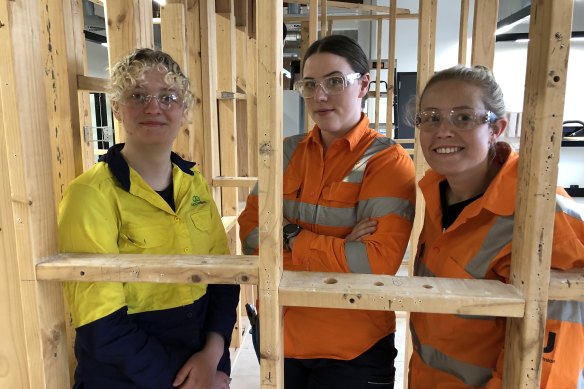By Sue White
Bridget Bottcher had been a chef for eight years when COVID hit. Like many Australians, the time out of work gave her a chance to think about her career, and at age 27, she decided to turn to trades.
Although nobody in Bottcher’s family was an electrician, she could see the field offered consistent work, no unsociable hours, and about $30,000 more a year than her chef’s salary.

Former chef Bridget Bottcher (centre) connected with a new network of women including Lily Kingston and Vanessa Tierney.
To get started, she enrolled in Australia’s first female-only pre-apprenticeship course for electricians at Victoria’s Holmesglen Institute. Sixty-three women have already graduated from the training, with more than 85 per cent going on to get jobs.
“I saw it as a really good opportunity to create a network of women who each understood what we were going through, and we could support each other,” Bottcher says.
Having an inbuilt network of contacts is something she believes is vital in a career, particularly a new one. “You need a strong backing to be successful and this can be hard to do in such a male-dominated industry,” Bottcher says.
Advocacy organisation Tradeswomen Australia (TWA) notes that although 65 trades are on Australia’s national skills priority list, women represent only 2 per cent of the trades workforce.
For some organisations, such as Endeavour Energy in western Sydney, the statistic is starting to budge. The organisation recently revealed that 60 per cent of its 2022 apprentice recruits were women. While these are impressive numbers, they are not represented industry-wide.
‘You need a strong backing to be successful and this can be hard to do in such a male-dominated industry.’
Bridget Bottcher
It’s one reason that earlier this year, Tradeswomen Australia joined Empowered Women in Trades and the National Association for Women in Construction to welcome measures announced in the federal budget that will help start to address the inequity for women in Australian trades.
The groups’ leaders highlighted several positives from the budget, including: the focus on women’s participation in labour markets in the national skills agreement (a $3.7 billion, five-year commitment to increase access for all to vocational education and training); targets to boost women’s participation in apprenticeships; and $5 million to better support women in male-dominated industries.
“I think for too long we have sought and argued for systemic change to address and change the stubborn statistic of only 2 per cent of women on tools in trades, and our sense now is that we are getting the right levers in place to get that change started.” Atherton says.
For Bottcher, that change is now well underway. She started working with one of the organisations that visited her classmates during her pre-apprenticeship and says she’s still in contact with the other women from the course.
“We connect over everything from finding women’s workwear that fits to the idiosyncrasies of the people we work with; if this or that is ‘normal’ – to be expected – or if we should be taking issues further.”
She’s encouraging of other women keen to start evening up the gender imbalance in trades.
“If you enjoy working with your hands being active and constantly learning, then you should really give it a go. There are so many opportunities to be utilised and skills to be gained. While it can be mentally and physically challenging at times you can find satisfaction in pushing through,” she says.
Women and trades
- A pre-apprenticeship course can be a good way to learn more about a potential trade.
- About 8 per cent of Australia’s electricians are women, although across the board only 2 per cent of our tradespeople are female.
- Mentoring, female-only training options, and connecting with networks of other women in the field can all offer benefits for women in trades.
The Business Briefing newsletter delivers major stories, exclusive coverage and expert opinion. Sign up to get it every weekday morning.